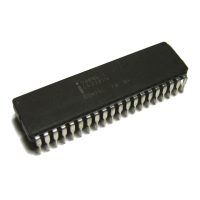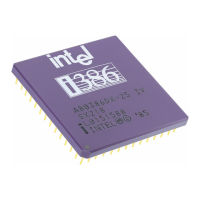80286
BASE ARCHITECTURE
Each byte within a word has its
own
particular address, and the smaller of the
two
addresses
is
used
as the address of the word. The byte
at
this lower address contains the eight least significant bits of
the word, while the byte
at
the higher address contains the eight most significant bits. The arrangement
of bytes within words
is
illustrated
in
figure
2-2.
Note that a word need not be aligned
at
an even-numbered byte address. This allows maximum flexi-
bility in data structures (e.g., records containing mixed byte and
word
entries) and efficiency
in
memory
utilization. Although actual transfers of data between the processor and memory take place at physi-
cally aligned word boundaries, the 80286 converts requests for unaligned words into the appropriate
sequences of requests acceptable
to
the memory interface. Such odd aligned word transfers, however,
may impact performance
by
requiring
t'Yo
memory cycles to transfer the word rather than one. Data
structures (e.g., stacks) should therefore be designed in such a
way
that word operands are aligned on
word boundaries whenever possible for maximum system performance. Due
to
instruction prefetching
and queueing within the CPU, there
is
no
requirement for instructions
to
be
aligned
on
word bounda-
ries and
no
performance
loss
if they are not.
Although bytes and words are the fundamental data types of operands, the processor also supports
additional interpretations
on
these bytes or
words.
Depending
on
the instruction referencing the operand,
the following additional data types can be recognized:
Integer:
A signed binary numeric value contained
in
an 8-bit byte or a 16-bit word. All operations assume a
2's complement representation. (Signed 32- and 64-bit integers are supported using the 80287
Numeric Data Processor.)
BYTE
ADDRESS'
'r
E
D
C
B
A
9
8
7
6
5
4
3
2
o
MEMORY
VALUES
FE
06
1F
23
OB
74
CB
31
"
I
WORD
AT
ADDRESS
B
CONTAINS
FE06
)
BYTE
AT
ADDRESS
9
CONTAINS
1F
I
WORD
AT
ADDRESS
6
CONTAINS
230B
I
WORD
AT
ADDRESS
2
CONTAINS
74CB
I
WORD
AT
ADDRESS
1
CONTAINS
CB31
'NOTE:
ALL
VALUES
IN
HEXADECIMAL
Figure 2-2. Bytes and Words
in
Memory
2-3
G30108
